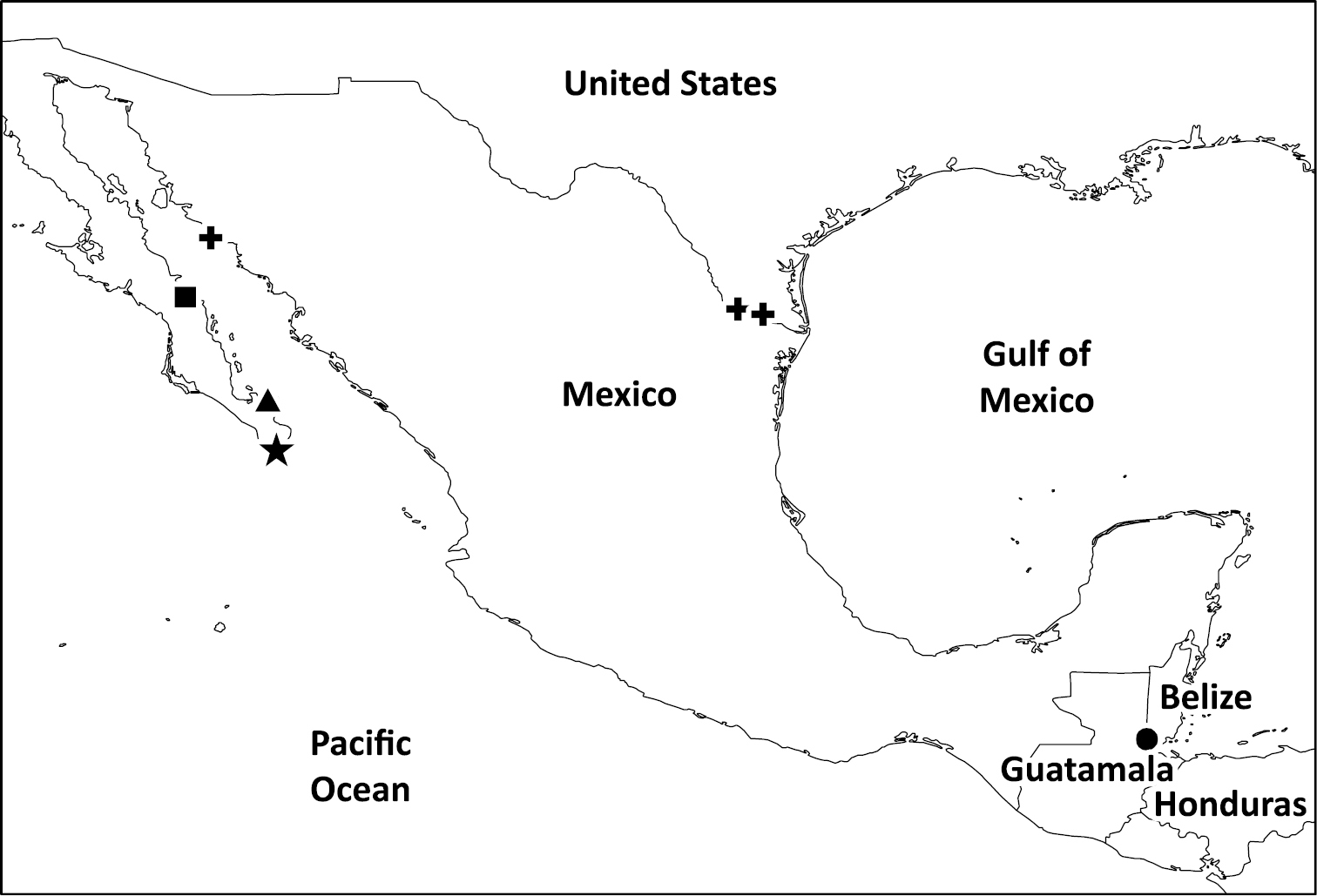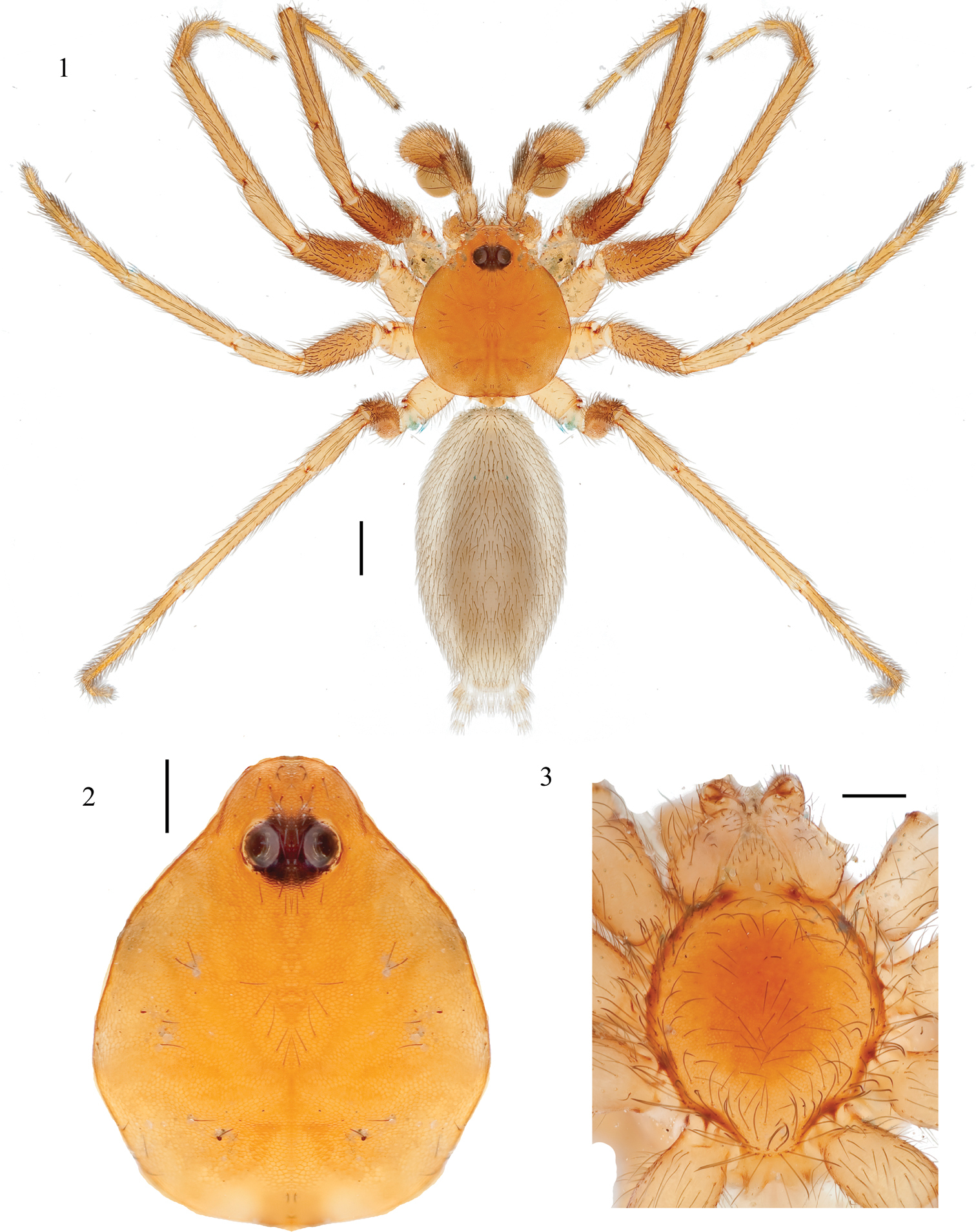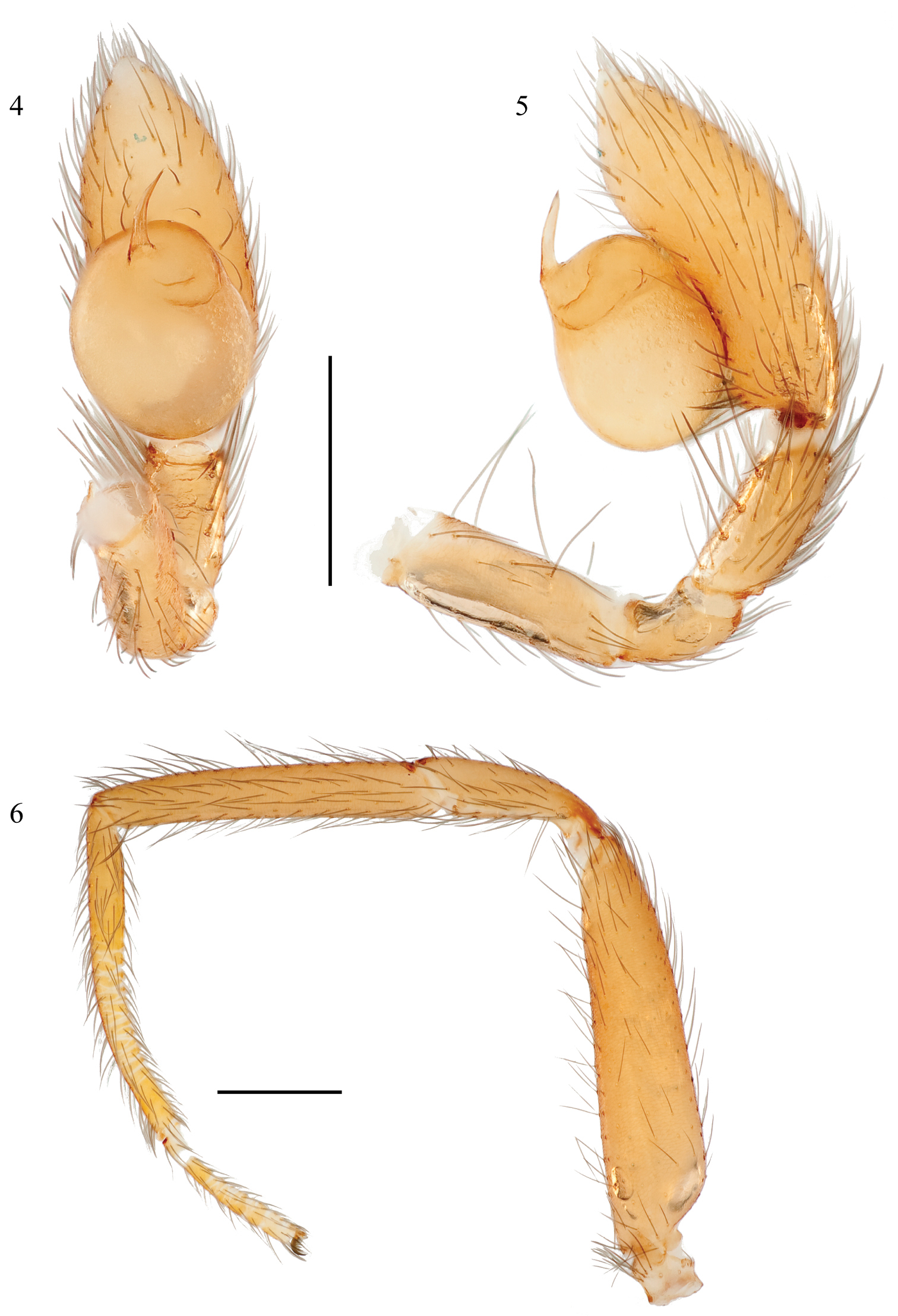






(C) 2013 Jason E. Bond. This is an open access article distributed under the terms of the Creative Commons Attribution License 3.0 (CC-BY), which permits unrestricted use, distribution, and reproduction in any medium, provided the original author and source are credited.
For reference, use of the paginated PDF or printed version of this article is recommended.
A new species of Caponiidae, Tarsonops irataylori sp. n. is described from southern Belize, and a key to the genera of the subfamily Nopinae is provided.
Spider, Tarsonops, new species, Belize
Comprising 84 species parceled among 15 genera (
The genus Tarsonops, the subject of this paper, was erected by
The primary purpose of this paper is to describe a new species of Tarsonops collected from Belize and to provide a key for the nopine genera. Unfortunately, this newly discovered species is known from only a single specimen. While a large of number of new species are described only from single specimens, greater than 1/6th of all species (
Character states for genera of Nopinae (Caponiidae) compared to Tarsonops irataylori sp. n.
| Taxon | |||||||
|---|---|---|---|---|---|---|---|
| Character | Cubanops | Nops | Nopsides | Nyetnops | Orthonops |
Tarsonops (all other species) |
Tarsonops irataylori sp. n. |
| Number of eyes | 2 | 2 | 4 | 2 | 2 | 2 | 2 |
| Ventral translucent keel on the anterior metatarsi and translucent extension of the membrane between the anterior metatarsi and tarsi | yes | yes | no | no | yes | yes | no |
| Distally expanded endites | no | no | yes | yes | no | no | no |
| Patterned carapace | yes | no | no | yes | no | no | no |
| Dorsally extended inferior claw | no | yes | yes | no | no | no | no |
| Wide labium | yes | no | no | no | no | no | no |
| Bisegmented metatarsi IV | yes | yes | ? | no | no | no | no |
| Palpal bulb longer than cymbium, distinction evident between bulb and embolus only by differences in cuticular surface | no | no | no | yes | no | no | no |
| Anterior tarsus with a distinct suture dividing it into two, the distal of which is shorter (versus anterior tarsus with several false sutures, most distinct of which is proximal | yes | yes | yes | yes | yes | no | no |
| 1 | 4 eyes | Nopsides Chamberlin, 1924 |
| 1’ | 2 eyes | 2 |
| 2 | Palpal endites (both sexes) expanded anteriorally, broadest at anterior apex of labium (see |
Nyetnops Platnick & Lise, 2007 |
| 2’ | Palpal endites (both sexes) not broadest anterior to apex of labium; normal palpal bulb with distinct embolus | 3 |
| 3 | Anterior tarsus with distinct suture that divides article into two distinct sub-segments | 4 |
| 3’ | Anterior tarsus with several false sutures, lacking distinct suture, not divided into two distinct sub-segments | Tarsonops Chamberlin, 1924 |
| 4 | Metatarsus IV divided into two distinct subsegments | 5 |
| 4’ | Metatarsus IV entire | Orthonops Chamberlin, 1924 |
| 5 | Tarsus I with inferior claw extended dorsally between superior claws; carapace generally lacking distinct patterning | Nops MacLeay, 1839 |
| 5’ | Tarsus I with inferior claw not extending dorsally between superior claws; carapace patterned | Cubanops Sánchez-Ruiz et al., 2010 |
All measurements were taken with a Leica MZ16.5 stereomicroscope equipped with a 10× ocular and ocular micrometer scale. We measured the left appendage, usually in retrolateral view, using the highest magnification possible. Legs I-IV (femur, patella, tibia, metatarsus, tarsus) and palp article lengths (femur, patella, tibia, cymbium) given in order of proximal to distal. Illustrations were prepared using a Visionary Digital Imaging System (Ashland, VA). Photographs were recorded in multiple focal planes and assembled using the Zerene Stacker software package (Zerene Systems LLC, Richland, WA). The habitus illustration was constructed from whole body images that were bisected, copied, and reflected in Adobe Photoshop (Adobe Systems, Inc.) to produce a roughly symmetrical image (technique described in
urn:lsid:zoobank.org:act:4B93D052-EA8C-43E7-A5D4-28A52FE05DBE
http://species-id.net/wiki/Tarsonops_irataylori
Map 1, Figs 1–6Holotype male from BELIZE: Toledo District: Cave near Pueblo Creek Cave: 37 km WNW of Punta Gorda, 16°12'N, 89°08'W (Figure 1): 16 April 2011: sjt11-018: Coll. Michael E. Slay, Jean K. Krejca, Christy M. Slay, Geoffrey B. Hoese, Germano Coe. Sample# 253, Specimen# 0222. On dry flowstone in entrance zone, 0.1 lux, air temperature 25.7 °C, soil temperature 23.5 °C, relative humidity 91.2%. Deposited in the Auburn University Museum of Natural History collection.
Distribution of Tarsonops species: Tarsonops sternalis (star), Tarsonops sectipes (triangle), Tarsonops clavis (square), Tarsonops systematicus (crosses, also recorded from California and Arizona, see
The specific epithet honors the contributions of Mr. Ira W. Taylor to the study of subterranean ecosystems.
Diagnosis. Tarsonops irataylori sp. n. differs from all known species of Tarsonops by the absence of a ventral translucent keel on the anterior metatarsi and a highly reduced translucent extension of the membrane between the anterior metatarsi and tarsi.
Specimen preparation and condition. Specimen collected live, preserved in 70% ethanol. Coloration may be faded. Pedipalp, leg I left side removed and stored in vial with specimen. General coloration. Carapace, chelicerae, legs light orangish red (Figs 1, 2). Abdomen uniform very pale grayish brown dorsally. No dorsal carapace or abdominal patterning. Cephalothorax. Carapace 1.56 long, 1.40 wide, with sparse thin setae, surface lightly granular (Fig. 3), pars cephalica elevated slightly. Clypeus height 1.5× eye diameter. Two eyes, eyes separated by distance equal to radius. Sternum lightly setose, widest between coxae II, III (Fig. 4). Sternum length 1.12, width 1.00. Palpal endites rectangular, anterior margin rounded, extending slightly beyond anterior margin of labium (Fig. 4). Labium width 0.348, length 0.244. Legs. Leg I: 1.67, 0.740, 1.34, 1.41, 0.626; Leg II: 1.672, 0.751, 1.335, 1.485, 0.568; Leg III: 1.401, 0.600, 1.120, 1.404, 0.720; Leg IV: 1.814, 0.663, 1.509, 2.000, 1.028. Legs I-IV metatarsi and tarsi subsegmented distally (Fig. 6). Superior tarsal claw, Leg I with 5 teeth; inferior tarsal claw not extending dorsally between superior tarsal claws. Tarsus I with two trichobothria. Metatarsus I with 4 trichobothria, arranged along dorsal midline, lacking a ventral translucent keel, translucent extension of the membrane between the anterior metatarsus I and tarsus I greatly reduced, barely evident on close examination as wrinkled bump. Leg I illustrated in Figure 6. Pedipalp. (Figs 5, 6): 0.522, 0.270, 0.357, 0.940; bulb total length 0.618. Dense group of setae on prolateral tibial surface. Embolus short, less than 1/4th length of bulb, tapering to sharp single point, bulb sub-spherical.
Tarsonops irataylor sp. n., male holotype 1 habitus, dorsal view 2 carapace, dorsal view 3 cephalothorax, ventral view. Scale bar = 0.50 mm (Fig. 1); 0.25 mm (Figs 2, 3)
Tarsonops irataylor sp. n., male holotype. 4 left pedipalp, ventral view 5 left pedipalp, retrolateral view 6 leg I, retrolateral view. Scale bars = 0.50 mm.
Although this species was taken from just inside a cave, it does not exhibit any obvious troglomorphies, and may be accidental in this habitat. The description of Tarsonops irataylori sp. n. extends the range of the genus 9 degrees east and 6.8 degrees south from the previously known range. A number of undescribed species of Tarsonops are known from collections in Mexico (Platnick, pers. comm. 31 October 2011).
Tarsonops irataylori sp. n. is the first species of Tarsonops described which lacks a ventral translucent keel on the anterior metatarsi and marked translucent extension of the membrane between the anterior metatarsi and tarsi.
We thank Michael E. Slay, Jean K. Krejca, Christy M. Slay, Geoffrey B. Hoese, Germano Coe for collecting this specimen and Bruno Kuppinger for hosting us during our stay in Belize. Fieldwork was conducted under a permit to Steven J. Taylor from the Institute of Archaeology, Archaeology Museum & Research Centre, Belmopan City, Belize C.A. and the Forest Department, Ministry of Natural Resources and the Environment, Belmopan City, Belize C.A. Funding for fieldwork was provided by the Subterranean Ecology Institute, Inc. Champaign IL USA and by and NSS International Exploration Grant from the National Speleological Society Foundation. The manuscript was improved through the careful comments provided by Darrell Ubick; Norman Platnick kindly assisted in the identification of this species. This paper is Contribution No. 685 of the Auburn University Museum of Natural History.


